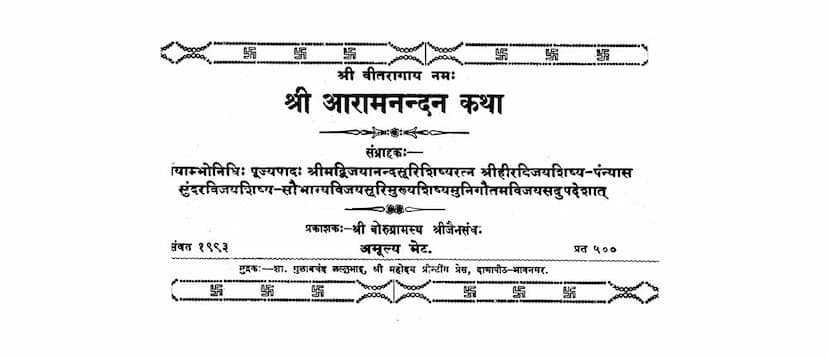Aram Nandan Katha
Added to library: September 1, 2025

Summary
Here's a comprehensive summary of the Jain text "Aram Nandan Katha," based on the provided pages:
Book Title: Aram Nandan Katha (The Story of Aram Nandan) Author: Gautamvijay Publisher: Jain Sangh Boru Theme: The story primarily illustrates the importance of Samayaktva (Right Faith/Perception) in Jainism and its power to overcome obstacles and lead to spiritual progress.
Overview:
The "Aram Nandan Katha" is presented as a narrative to explain the concept of Samayaktva. It chronicles the life and experiences of Aram Nandan, a virtuous individual who, despite facing numerous trials and temptations, remains steadfast in his Jain faith and principles. The story highlights the significance of divine intervention, good deeds, and unwavering devotion in achieving spiritual liberation.
Key Aspects and Narrative Flow:
-
Introduction and Patronage: The book begins with acknowledgments to various individuals and organizations who supported its publication, indicating its dissemination within the Jain community. It also includes a brief biography of Muni Maharaj Shri Kanakvijayji, whose teachings inspired the author.
-
The Birth and Early Life of Aram Nandan:
- The story is set in the city of Lakshmipur in the Bharat Kshetra of Jambu island.
- Aram Nandan is born as the son of King Vikrama and Queen Padmshri.
- Initially, his mother Padmshri is barren, and a monkey, through a magical herb, helps her conceive. This leads to Aram Nandan being born as a monkey, much to his mother's dismay.
- However, through divine grace and perhaps the merit of his past lives, he is eventually raised as a human. He is named Aram Nandan (meaning "Joy of the Garden" or "Delight of the Garden").
-
Trials and Triumphs of Aram Nandan:
- The Mysterious Flower Garment: Aram Nandan's wife, Padmavati, desires a special flower garment found in the Narmada river. While trying to retrieve it, Aram Nandan encounters a celestial being (likely a Yaksha or Yakshini) who manifests from the garment. This encounter leads to a series of adventures where the flower garment plays a significant role.
- The Elephant Rescue: Aram Nandan demonstrates his intelligence and resourcefulness by rescuing a royal elephant that gets stuck in mud. His efforts impress the king, leading to him being rewarded. This event showcases his competence and the king's favor.
- Commercial Ventures and Adventures: Aram Nandan engages in various trade expeditions. During one such voyage, his ship is threatened by a storm, and he faces challenges related to his cargo, particularly a consignment of valuable "chhaganas" (likely referring to valuable goods or jewels). He skillfully navigates these challenges, demonstrating his wisdom and business acumen.
- Confrontation with Deceptive Practices: The story depicts Aram Nandan encountering dishonest merchants who try to cheat him. He uses his sharp intellect and adherence to principles to expose their deceit and secure his rightful gains.
- The Golden Man: Aram Nandan is involved in a magical ritual where a golden man is created from fire. He faces temptations and has to discern the true nature of the ritual and the involved entities. This segment likely emphasizes the importance of right knowledge and perception.
- The Enchantress and the Flower Garment's Origin: Aram Nandan learns about the origin of the flower garment from a group of Yoginis. They recount a story of a Vidyadhara (celestial being) named Vidyunmali who obtained the garment and the subsequent complications it caused, including the death of his beloved wife. This part highlights how attachments and desires, even for seemingly beautiful things, can lead to suffering.
- The Test of Samayaktva: Aram Nandan faces a severe test where his son falls ill. A sorcerer claims that the boy can only be cured if Aram Nandan worships other deities besides the Jinas. Despite the dire situation and the potential loss of his son, Aram Nandan steadfastly refuses to compromise his Samayaktva, emphasizing that true faith is paramount. This is a crucial demonstration of his unwavering adherence to Jain principles.
- The Divine Intervention and Reconciliation: Ultimately, due to his unwavering faith, divine forces intervene. His son is healed, and the sorcerer is revealed to be acting under divine direction to test Aram Nandan's faith. The story emphasizes that genuine Samayaktva attracts divine grace.
-
The Legacy of Aram Nandan:
- Aram Nandan lives a life of righteousness, performing good deeds, supporting religious institutions, and spreading the Jain dharma.
- He achieves spiritual merit and ultimately attains liberation (moksha).
Core Message of Samayaktva:
The "Aram Nandan Katha" powerfully illustrates that:
- Samayaktva is the foundation of spiritual life: Without right faith in the Tirthankaras, the scriptures, and the path to liberation, no progress can be made.
- Samayaktva provides strength in adversity: It gives individuals the fortitude to face challenges, temptations, and personal tragedies without deviating from their principles.
- Samayaktva attracts divine favor: Those who are steadfast in their faith are often aided by celestial beings and divine powers.
- Samayaktva leads to liberation: It is the ultimate key to breaking the cycle of birth and death and achieving eternal bliss.
In essence, the story of Aram Nandan is an allegorical representation of a soul's journey, emphasizing that through unwavering adherence to Jain principles, particularly Samayaktva, one can overcome all worldly obstacles and attain the highest spiritual goal.